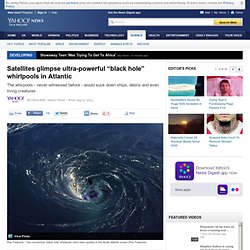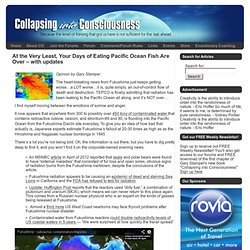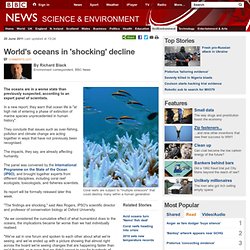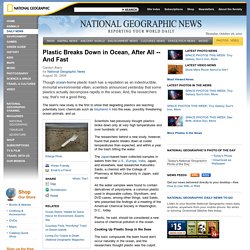

Plastic-Free Oceans. Satellites glimpse ultra-powerful “black hole” whirlpools in Atlantic. Satellites have shown two mysterious 'black hole' whirlpools in the South Atlantic ocean - ultra powerful “vortexes” which suck water down into the depths.

The whirpools - never witnessed before - would suck down ships, debris and even living creatures, moving 1.3 million cubic metres of water per second. Two of the black holes - or “maelstroms” - have been sighted in three months by physicists from Zurich and Miami. The powerful vortices of current have been described as ‘maelstroms’ and are ‘mathematical analogues’ for black holes – which is to say they do exactly the same with water that black holes do with light.
A whirlpool pictured by NASA. The discovery could give new insights into how oceanic currents transport debris and may even have implications for climate change studies. Astronomical black holes bend space and time into a perpetually collapsing vortex. At the Very Least, Your Days of Eating Pacific Ocean Fish Are Over. Opinion by Gary Stamper The heart-breaking news from Fukushima just keeps getting worse…a LOT worse…it is, quite simply, an out-of-control flow of death and destruction.

TEPCO is finally admitting that radiation has been leaking to the Pacific Ocean all along. and it’s NOT over…. I find myself moving between the emotions of sorrow and anger. It now appears that anywhere from 300 to possibly over 450 tons of contaminated water that contains radioactive iodone, cesium, and strontium-89 and 90, is flooding into the Pacific Ocean from the Fukushima Daichi site everyday. To give you an idea of how bad that actually is, Japanese experts estimate Fukushima’s fallout at 20-30 times as high as as the Hiroshima and Nagasaki nuclear bombings in 1945 There’s a lot you’re not being told. NASA Visualizes The World’s Ocean Currents, Van Gogh-Style.
NASA Goddard Scientific Visualization Studio created an animation visualizing how water moves around the world.

The video ‘Perpetual Ocean’ shows the surface current flow of oceans around the world, from July 2005 to November 2007. The white lines represent the currents, while the darker blue colors represent the “bathymetry” (ocean topography), according to Fast Co. Design. The mesmerizing video—which resembles Van Gogh’s ‘Starry Night’—was assembled through a combination of satellite, location and computational data generated by ECCO2 (Estimating the Circulation and Climate of the Ocean, Phase 2).
[via Fast Co. Receive interesting stories like this one in your inbox. Home. Ocean Protection. World's oceans in 'shocking' decline. 20 June 2011Last updated at 13:24 By Richard Black Environment correspondent, BBC News Coral reefs are subject to "multiple stressors" that could destroy many within a human generation The oceans are in a worse state than previously suspected, according to an expert panel of scientists.

In a new report, they warn that ocean life is "at high risk of entering a phase of extinction of marine species unprecedented in human history". They conclude that issues such as over-fishing, pollution and climate change are acting together in ways that have not previously been recognised. The impacts, they say, are already affecting humanity.
The panel was convened by the International Programme on the State of the Ocean (IPSO), and brought together experts from different disciplines, including coral reef ecologists, toxicologists, and fisheries scientists. Its report will be formally released later this week. Fast changes. Www.nefsc.noaa.gov/publications/crd/crd0511/crd0511.pdf. Monitoring information of environmental radioactivity level. Oceana (Oceana) Narragansett Bay Estuary Program - NBEP - Rhode Island. Deep ocean wilderness destruction. By Severin Carrell, 16 October 2005 The deep ocean is one of the world's last great wildernesses.

But not for long. Two kilometres below the surface, scores of rare and exotic species are being wiped out at a dramatic rate. These unique species include the goblin shark which boasts a unicorn-like horn, prickly sharks with humped backs and glowing eyes, vast single-celled organisms as large as footballs and tripod fish that stand on their fins. In a letter passed to The Independent on Sunday, Britain's leading marine scientists have warned these species face extinction because of the global growth in deep-sea trawlers fishing for edible species such as the orange roughy, hoki and round-nosed grenadier.
The damage is indiscriminate, they warned. Plastic Breaks Down in Ocean, After All. August 20, 2009 Though ocean-borne plastic trash has a reputation as an indestructible, immortal environmental villain, scientists announced yesterday that some plastics actually decompose rapidly in the ocean.

And, the researchers say, that's not a good thing. The team's new study is the first to show that degrading plastics are leaching potentially toxic chemicals such as bisphenol A into the seas, possibly threatening ocean animals, and us. Scientists had previously thought plastics broke down only at very high temperatures and over hundreds of years. The researchers behind a new study, however, found that plastic breaks down at cooler temperatures than expected, and within a year of the trash hitting the water. Floods in Sri Lanka: Troubled waters in need of bridges.